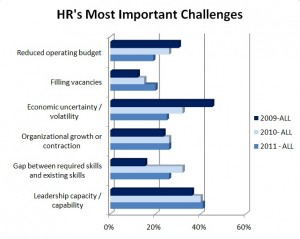Business Intelligence Makes For Smart HR Leadership
By Ian J. Cook, CHRP
The HR profession continues to expand in terms of scope and complexity. One area that is emerging as a core element of strategic contribution is the area of HR analytics. The growth of analytical work mirrors a broader development that is affecting business and organizations in general. This broader development has been termed Business Intelligence.
According to Wikipedia, “business intelligence (BI) refers to computer-based techniques used in identifying, extracting, and analyzing business data, such as sales revenue by products and/or departments, or by associated costs and incomes. BI provides historical, current and predictive views of business operations with the aim to support better business decision-making.”
As business activities are increasingly tracked and processed through software, this leads to ever deeper banks of data that can be analyzed. The right analysis leads to unique insights, better decisions and better outcomes. HR has followed this digital revolution and is slowly getting drawn into organizational BI activities. McKinsey and Co., a top tier consulting firm, recently posed the question: “Are you using your people data to drive value?” suggesting that CEO’s should be holding their CHRO’s and HR groups accountable for integrating analytical disciplines with people decisions and practices.
While we cannot now imagine running an organization without computers, in the near future no one will run their organizations without broad access to data and analytical tools. BI and analytics is here to stay.
That said, the practice of HR analytics is still young, complex and many of the challenges or problems are unsolved. It is an emerging area of HR that is attractive to those with a pioneer spirit ready to put their minds and talents towards building a new, different and highly influential area of HR practice.
HR Leadership: Don’t Train in Vain
The chart below shows the areas that HR professionals believe will most impact their organization over the next 12 months. The chart shows the trends in these areas for the last three years. Although there is variation, the biggest concern throughout has been the development of leadership capability. So how would we apply an analytical approach to solving this challenge?

One of the first questions to answer is who do we need to develop? Identifying the target group -before identifying what skills and abilities you will develop ensures that you match the learning to the learner. Many organizations hold off developing their frontline staff for fear that the investment in learning will be wasted when the person moves on to another organization. This is a legitimate concern and a place where analytics can help.
Two years of data from the HR Metrics Service shows that voluntary turnover reduces significantly after people have been with an organization for more than three years. Therefore, a way to minimize your investment risk is to select from the group of staff that have been with the organization for more than three years. If you do not have any of these people then you know you have another issue to solve first.
The second criteria should reflect the current and future capabilities of the individuals. There should be a performance threshold so that you are not investing in the people who are not contributing as required. Your future managers and leaders should be above average in their ability to get the work done and enable others get the work done. This data should be in your performance management records and is a primary reason to have effective performance management practices embedded in your organization.
The individuals also need to demonstrate an aptitude for managing people and tasks. This should be assessed using a standardized approach. Options include specific assessment tools, structured interviews with managers and the individual, test projects, etc… This qualitative step will also provide insight into what needs to be learned and how far the skills need to be developed before each individual is ready to progress within your organization.
Now you know who and what needs to be developed, you need to consider the level of investment required. Having minimized the risk of your learning investment being lost makes a stronger case for the right amount of investment. How do you determine what your budget should be?
Make Intelligent Investments
The median spend on learning and development in BC was 1.5% of total labour costs for 2010. As a benchmark, data from the American Society for Training and Development indicates that 2% of total labour costs is the median in the US. The group we have identified for development are core to an organization’s future and a key part of solving its most pressing challenge. They should receive a higher investment than the median.
Taking 2% of labour costs as the start point, then allocating twice the median spend to this group, based on their strategic importance, gives a start point for an appropriate budget. For example, for an individual earning $50,000 in salary and benefits, the median spend would be 2% or $1000 annually. If they are of strategic importance than this goes up to $2000 annually or 4% of their total labour costs. Aggregate this across the number of people you need to develop and you have your budget.
Business Intelligence Adds Up
How do you know if you have used your budget well? There are three sets of numbers which demonstrate this. The first is the succession planning rate, the second is the promotion rate, specifically promotions into management or leadership roles, and the third is your external hire rate for management or executive positions.
The succession planning rate shows how many candidates are ready to move into executive positions as a percentage of all executive positions. A rate of 50% means you have half of your executive team covered; a rate of 100% shows you have them all covered. If your leadership development program is delivering over a two year timeframe it will shift your succession planning rate upwards.
The promotion rate shows that you are able to move people upwards in the organization because they have the skills and capabilities required. Your leadership and management program is working when you can move individual contributors successfully into management roles and managers into more senior leadership roles. Tracking the quality of these moves is an important piece of supporting data.
The external hire rate demonstrates how often you have to go outside the organization for talent as opposed to moving someone upwards from within. Comparing the costs and risks of hiring a new leader as opposed to growing one can be a useful piece of analysis for supporting a higher development spend. You know that your leadership spend is working when your external hires are few and highly targeted.
When combined, these three metrics give you a robust, repeatable view of your leadership work and demonstrates whether or not the investment is paying the organization back through better promotions and lower costs and risks through external hiring. Together they make tangible both the purpose of the work and the outcomes that are being achieved.
The New HR Order
The changes in business practices outlined above are here to stay. There will be no return to intuition, qualitative guess work or simply following others. However, in the interim the solutions are not fully formed or fully proven. Achieving this more mature level of practice will take time, experimentation, intelligence and repetition.
It will involve applying the BI approach to information and analytics outlined above and then working through several cycles to confirm, refine and enhance this approach. The upside is nothing less than the future; those who undertake this work will be rewarded with unique insights and knowledge which will bring value to their organizations and their careers.
A global citizen, Ian J. Cook, MA, MBA, CHRP (ijcook@bchrma.org) has chosen to make his home in Vancouver where he heads up the growth of BC HRMA’s research and learning services. He has an MA from Edinburgh University, an MBA from Lancaster University and is a Certified Human Resources Professional. In his spare time, he can be found exploring BC’s amazing outdoors, with his wife and young family.
PeopleTalk: Summer 2011










